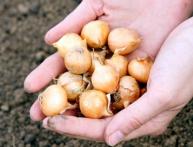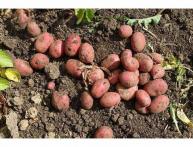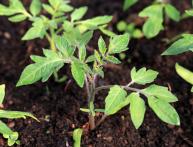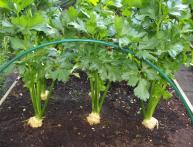Planting radishes in spring: main points worth paying attention to

Radish is one of the first vegetable crops that provides the body exhausted after winter with vitamins and necessary substances. This is a very healthy vegetable. In order for it to provide maximum benefits, it is recommended that you grow it yourself. How to plant radishes in the spring?
Content:
- What season to plant, how to choose soil and prepare for planting?
- Watering and temperature conditions
- What should be the care immediately after planting?
- Cultivation and care activities
What season to plant, how to choose soil and prepare for planting?
It is worth understanding that radish development occurs best during short daylight hours. This must be taken into account when choosing sowing dates. The formation of a good fruit is also affected by humidity, temperature, and feeding. Therefore, it is worth paying a little attention to radishes, then they will reward you with an excellent harvest. To do this, just follow the simplest rules.
There are early varieties. If you grow them, then you can enjoy the first fruits 4 weeks after the shoots appear. For this reason, it is recommended to start preparing the beds when it starts to get warmer. Radishes can withstand cold; they are not even afraid of frost at night.

Often, experienced gardeners plant at the end of March or early April, when the weather is already quite warm and the soil has already warmed up. But choose the timing landings worth it, taking into account the temperature conditions. Namely:
- Shoots will not appear for a long time if the temperature does not rise above +10 degrees.
- It will take 7 days for seedlings to appear if the indicators have increased to +15.
- Sprouts will be visible on the fourth day if the temperature remains around +20 degrees.
The best temperature for radishes to form well is considered to be +20 degrees. Therefore, it is worth paying attention to weather conditions. When they become favorable for planting, then it is necessary to sow the seeds. Initially, you need to decide on the place where the plant will be grown. Radishes prefer fertile soil.
Has a beneficial effect on root development feeding with the help of organic fertilizers. At the same time, it is better to prepare the territory in the autumn. At this time, it is necessary to add humus, manure and dig up the soil. Neutral acidity is ideal for radishes. But it can also develop on slightly acidic soil.
When a place for planting has been chosen, it is worth paying attention to whether it is illuminated normally by the sun. After all, radishes prefer well-lit areas.
It is necessary to ensure that the soil is loose. Otherwise, the radishes will bolt. This is also affected by excessively high temperatures or lack of watering. It is recommended to initially sort the seed material by size. This will allow you to get friendly shoots. The sprout from larger seeds will appear earlier. After sorting, it is necessary to place the planting material in water.
When miniature sprouts appear, then sowing can begin. There should be about 15 cm between each row, and 6 cm between plants. Where the seedlings initially appear, the plants will be grown there. Deepen seeds It doesn't really need to go into the ground. For this, 0.5 cm is enough. If everything is done correctly, shoots will soon appear.
Watering and temperature conditions
Video about growing radishes:
Radishes are a plant that needs regular watering. If the soil is moist, then the fruit will grow juicy and large. For this reason, it is necessary to fill the furrows with water during sowing. In the future, you should also not forget about the plant and water it regularly.
Naturally, there is no need to overdo it, as stagnation of water will negatively affect the radishes. It will cause the root crops to begin to rot, and over time they will die. Experienced gardeners advise watering radishes that were planted in March with warm water. It is especially useful to take an evening shower, which will help protect the plants when the temperature drops at night, as the heat will be retained.
What should be the care immediately after planting?
Radish does not require careful care, so even a beginner can grow it. Once it has been planted, you should adhere to these basic rules of care:
- The plant must be watered moderately regularly. This is especially important when it does not rain. Without proper moisture, root vegetables will not taste good.
- Don't overdo it with watering. Excess moisture may cause fruits to rot or crack.
- As soon as the seedlings begin to appear, it is worth adding potassium fertilizers to the soil. They are sold in special stores. But beginners are advised to initially read the instructions and then use fertilizers carefully.An overabundance can also have a detrimental effect on root vegetables.
Cultivation and care activities

Radishes need to adhere to certain rules regarding care. The most important of them:
- When about five days have passed after the seedlings have appeared, it is necessary to thin the rows.
- As soon as the plant has been watered, it is necessary to loosen the soil. This is a mandatory procedure after each watering.
- In the future, experienced gardeners add nitrogen fertilizers to the soil.
- The plant can be attacked by a variety of pests, so it is worth taking all measures to combat them. Treating the area with ash or dust from cigarettes is good for this.
Harvesting can be done selectively. Initially, those root crops that have formed are pulled out, and then all the rest. The harvest, which was collected in the autumn, can be stored in the cellar for a long period. So, radishes are a tasty and healthy vegetable. But not everyone is able to harvest a good and high-quality harvest. To do this, you should know some rules regarding planting and care.











Comments
Radishes are very demanding when it comes to watering, and if it is done rarely, the vegetable will be bitter and unpleasant in taste. In addition, do not forget to apply fertilizers on time and loosen the rows.